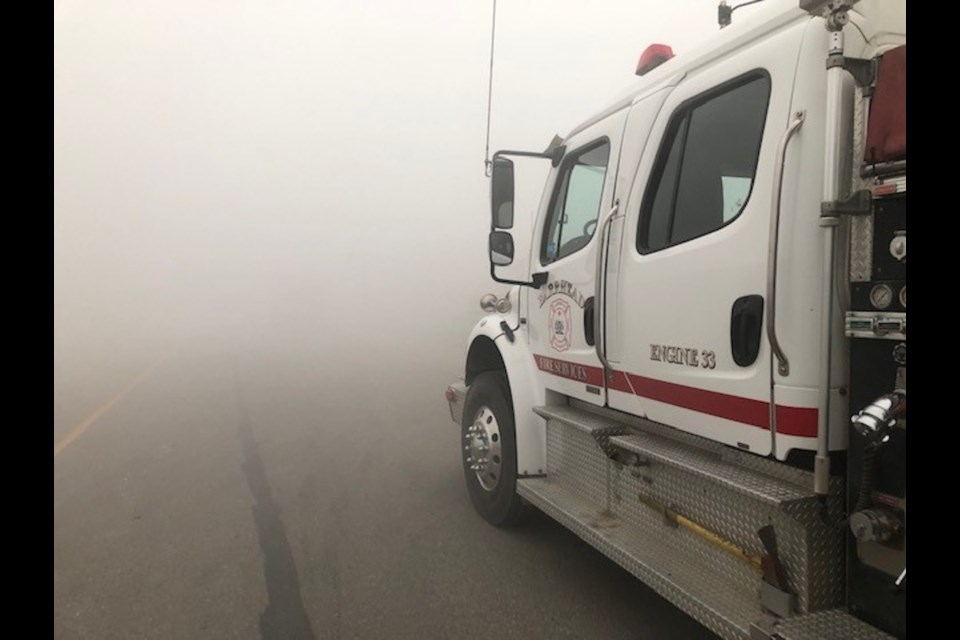BARRHEAD - Some Barrhead Regional Fire Services (BRFS) members gained a lot of frequent traveller miles this year.
In the 2023 fire season, BRFS firefighters and equipment responded to several calls from the province to help battle wildfires or to provide supplemental coverage, totalling 69 days.
And they might not be done yet.
BRFS deputy fire chief Ted Amos, who joined multiple deployments, said. However, the fires in northern Alberta are no longer getting the media coverage they once did as of late September; the province was still looking for fire departments to help battle wildfires or supplemental fire coverage, including the Barrhead department.
For instance, County of Barrhead manager Debbie Oyarzun told councillors at the Oct. 3 meeting stated that the previous day a group of BRFS firefighters and a fire engine departed for a provincial taskforce in High Level.
The travel started in early May when BRFS received a call to help battle the Drayton Valley - Buck Creek fire for about three weeks beginning May 5. A week later, the province asked Barrhead if they could send another crew, this time to help with the Rainbow/Long Lake fire.
After four days, the crew was transferred to the Peavine Metis Settlement Wildfire.
Later in June, a five-person crew, accompanied by Engine 33, went to Peace River as part of a quick strike task force, which, fortunately, did not have to be deployed.
Closer to home, the fire department also sent a crew and equipment to the Lac Ste. Anne County as part of the Lessard Lake Estate firefighting efforts.
However, their most recent deployment was the firefighting efforts, and the one that garnered the most national fire attention was the BRFS deployment to the Northwest Territories.
Amos said that on Aug. 20, firefighters loaded up Engine 33 onto a flatbed truck headed for Yellowknife while he and firefighters Jesse Whitney and Craig Plitt made their way to the Edmonton International Airport to catch a flight to the city.
"The city had a bit of an eerie ghost town feel to it," he said. "It was very quiet, with very little traffic or stores open."
The next day, most of their time was spent in various orientation sessions learning the fire's behaviour and movement, the task force configuration, and what emergency officials had done to protect the city using fireguards and large perimeter lines.
For the remainder of the week, Amos said they spent most of their time training with firefighters from Calgary, Edmonton, and Yellowknife firefighters, fire smarting around high value, i.e. high-threat, residential locations.
On Sunday, after spending the morning fire-smarting properties, before being told by Yellowknife fire chief Nelson Johnson while standing in the lunch line that they were to be redeployed to Hay River.
"We met no traffic, no hotels, no fire or smoke," he said, adding the drive was nearly six hours. "The only thing we saw until we crossed the Mackenzie River on the south side was a wild buffalo."
But as they got closer to Hay River, that eventually changed, Amos said, adding the Hay River fire conditions were very different.
"The large fires were burning. Miles of power poles were on the ground," he said, adding that as part of their journey, they went past the small village of Enterprise, which was heavily hit by the fire.
They arrived in the deserted Hay River late that night, heading straight for the fire hall to eat dinner before retiring to their hotel where other members of the firefighting effort were staying.
The following day, the trio met with the command team and task force they would work with for the remainder of their 12-day stay. They then took part in the morning briefing before taking a tour of the town to get the lay of the land and see the fire prevention methods other firefighters had taken to protect structures, with the most at-risk buildings protected with a sprinkler system.
Amos said that in the mornings, they would check on the water pump and sprinkler systems that had been to protect homes on the east side of the Hay River Highway.
"On Sept. 1 and 2, there was huge potential of extreme fire, so crews would patrol the Highway, putting out any spot fires as they encroached the ditch," he said. "Some of our other tasks [in our first week] included walking through the campground and subdivisions looking for any spot fires, wetting down cat guards put in place to protect the water treatment plant and working in the bush looking for and extinguishing any spot fires."
In their second week, Amos said, most of the heavy lifting was done by aircrews, with ground crews limited to maintaining fire prevention systems and looking for and putting out spot fires.
Barry Kerton, TownandCountryToday.com



